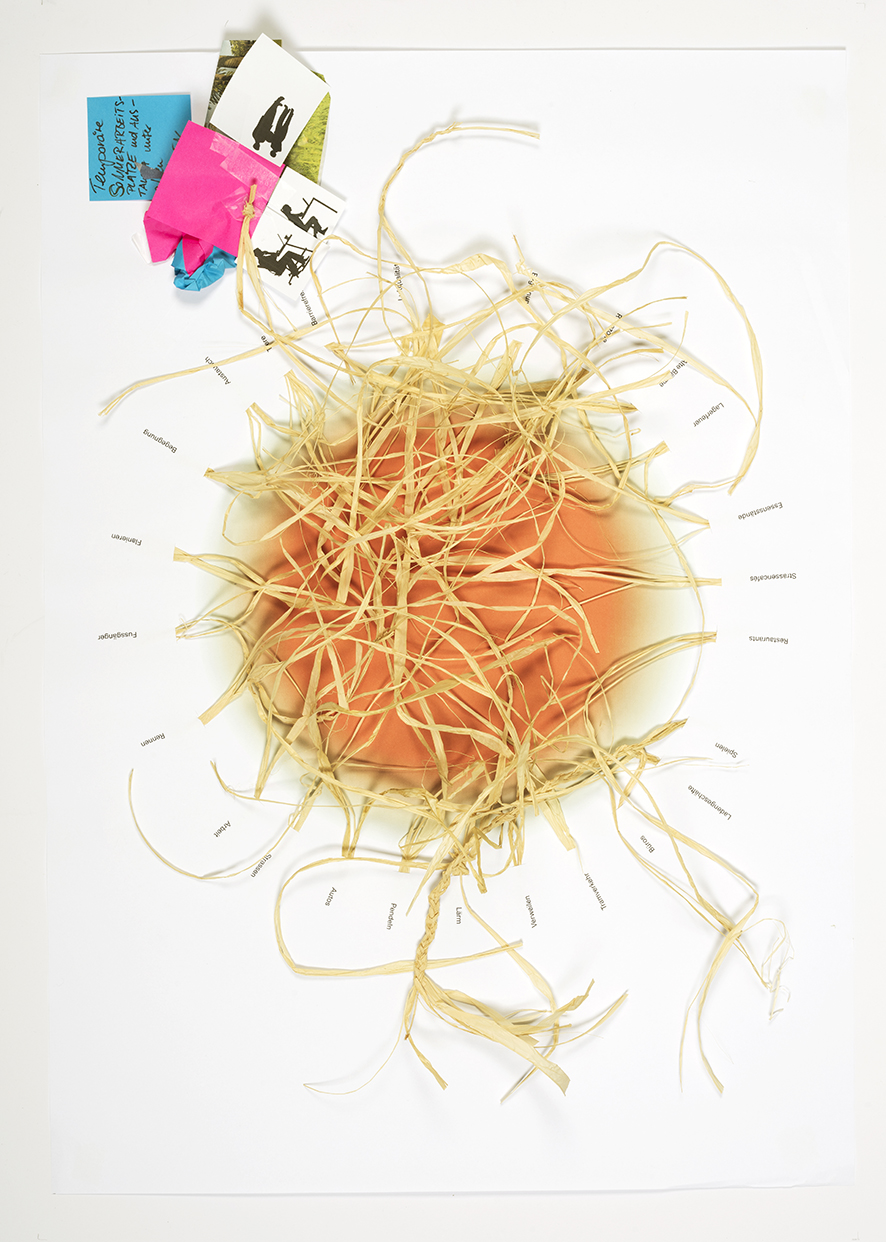Methods
Participatory Imagin(eer)ing II
For some of the participants,visualizing their thoughts as commensurable images poses a challenge. Without practice, drawing on a blank sheet of paper can seem insurmountable; it is not an everyday task. The using a collage technique in PI II serves us to lower the threshold for an emancipatory design of urban visions. It is intuitive and flexible and conveys this through its visual language with many possiblepictorial element combinations. The image pool from which new urban visions are created consists of the visual material that has been provided by various actors of the Klybeck planning process (see also “Archive” on this site).
We introduce this image pool and elements in different tasks during an events. Particular images are included and their format adapted to other methods as part of the process (see “Spatial*Conceptual Mosaic” on this site).
As the main task during PI II, we provide large-format printouts that include simplified line drawings as a visual basis that can be recognized in various social and professional contexts:
crosssections, perspectival views, and map layouts. These different viewpoints enable participants to approach the area with either a remote gaze on urban connections oratstreet level amongeveryday practices. The visual basis builds a frame that connects the created visions as the sum of various perspectives (X).
Similar to a grid, each basic drawing is reduced to lines that provide points of interaction that are inviting rather than imposing. Participants are offered a series of scenarios that include various urban situations depending on the specific interests of the workshop group (24-hour activity zone, harbor development, new cultural center, interim uses, etc.).
In smaller groups, participants negotiate and visualize one of the future scenarios together. A large selection of image fragments is available for the visual communication of ideas in the form of a collage on top of the visual basis. As interlocutors have suggestedduring preparatory meetings, we have begun to make an inventory ofthe image pool according to more general categories: people and activities; public and individual traffic;residential, commercial,and office buildings;plants and green public spaces;sensory experiences,such as noise and smells, and various everyday situations inthe neighborhood. For further individuation, empty speech and thought bubbles, different colored sheets of paper, tapes and pens, and cutters are made available.
In the next step, participants select image elements, discuss and decide together, and adapt visual compositions. The negotiations are visual, verbal, and embodied. While these take place, participants begin to question not just others’ but also reflect upon their own position and opinions during and after collaborative activities. Priorities are negotiated and compromises made in the interplay of intuitive image design and lively discussion.
Each of the incremental image-making processes as part of an icono-ethnography considers the respective spatial and socio-cultural context,as well as key questions formulated by participants. The results are presented to the whole group and form the basis for deep discussion and feedback among all workshop participants. These insights are then taken into research and the next event.
We introduce this image pool and elements in different tasks during an events. Particular images are included and their format adapted to other methods as part of the process (see “Spatial*Conceptual Mosaic” on this site).
As the main task during PI II, we provide large-format printouts that include simplified line drawings as a visual basis that can be recognized in various social and professional contexts:
crosssections, perspectival views, and map layouts. These different viewpoints enable participants to approach the area with either a remote gaze on urban connections oratstreet level amongeveryday practices. The visual basis builds a frame that connects the created visions as the sum of various perspectives (X).
Similar to a grid, each basic drawing is reduced to lines that provide points of interaction that are inviting rather than imposing. Participants are offered a series of scenarios that include various urban situations depending on the specific interests of the workshop group (24-hour activity zone, harbor development, new cultural center, interim uses, etc.).
In smaller groups, participants negotiate and visualize one of the future scenarios together. A large selection of image fragments is available for the visual communication of ideas in the form of a collage on top of the visual basis. As interlocutors have suggestedduring preparatory meetings, we have begun to make an inventory ofthe image pool according to more general categories: people and activities; public and individual traffic;residential, commercial,and office buildings;plants and green public spaces;sensory experiences,such as noise and smells, and various everyday situations inthe neighborhood. For further individuation, empty speech and thought bubbles, different colored sheets of paper, tapes and pens, and cutters are made available.
In the next step, participants select image elements, discuss and decide together, and adapt visual compositions. The negotiations are visual, verbal, and embodied. While these take place, participants begin to question not just others’ but also reflect upon their own position and opinions during and after collaborative activities. Priorities are negotiated and compromises made in the interplay of intuitive image design and lively discussion.
Each of the incremental image-making processes as part of an icono-ethnography considers the respective spatial and socio-cultural context,as well as key questions formulated by participants. The results are presented to the whole group and form the basis for deep discussion and feedback among all workshop participants. These insights are then taken into research and the next event.








